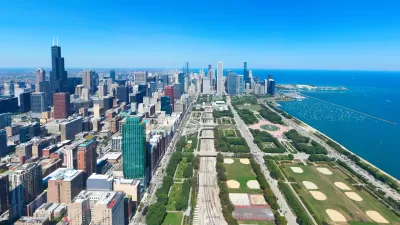Preservationists have been outspoken in arguing for the protection of Prentice Women’s Hospital. Rather than bemoan Northwestern University's intransigence in finding a way to reuse the hospital, two powerful figures have put forth a way to save it.
Petitions have been signed, columns have been written, awareness has been raised, but up until know, efforts to explain the importance of protecting Bertrand Goldberg's Prentice Women's Hospital from demolition seem to have failed to sway the property owner, Northwestern University, or local officials in Chicago.
In a last ditch effort to convince the powers that be that protecting the building is possible, Michael Kimmelman, architecture critic for The New York Times, and Jeanne Gang, one of Chicago's most celebrated architects, have stepped forth with a bold proposal for saving the late-Modernist landmark by building a research tower on top of it. "Great buildings have often survived the wrecking ball by being added to,
incorporated into larger structures or updated for a new era - in Rome and Istanbul, New York and Chicago," says Kimmelman. "Adding on top of the old Prentice is intended as a thought exercise in
what might be called a third way that may not always get its due in
preservation battles."
With that approach in mind, Gang developed a concept for adding 600,000 square feet of new space in a 31-story tower atop the hospital's cloverleaf, "adding a shapely new landmark to the skyline."
"The university says it wants to be a good neighbor," observes Kimmelman. "Diversifying the
neighborhood while incorporating Goldberg's building into some new
structure would allow the university to save lives, develop a healthier
urban plan and sustain a special work of local culture, which is also
what great universities do."
FULL STORY: A Vision to Avoid Demolition for a ’70s Pioneer

Trump Administration Could Effectively End Housing Voucher Program
Federal officials are eyeing major cuts to the Section 8 program that helps millions of low-income households pay rent.

Planetizen Federal Action Tracker
A weekly monitor of how Trump’s orders and actions are impacting planners and planning in America.

Ken Jennings Launches Transit Web Series
The Jeopardy champ wants you to ride public transit.

Crime Continues to Drop on Philly, San Francisco Transit Systems
SEPTA and BART both saw significant declines in violent crime in the first quarter of 2025.

How South LA Green Spaces Power Community Health and Hope
Green spaces like South L.A. Wetlands Park are helping South Los Angeles residents promote healthy lifestyles, build community, and advocate for improvements that reflect local needs in historically underserved neighborhoods.

Sacramento Plans ‘Quick-Build’ Road Safety Projects
The city wants to accelerate small-scale safety improvements that use low-cost equipment to make an impact at dangerous intersections.
Urban Design for Planners 1: Software Tools
This six-course series explores essential urban design concepts using open source software and equips planners with the tools they need to participate fully in the urban design process.
Planning for Universal Design
Learn the tools for implementing Universal Design in planning regulations.
Heyer Gruel & Associates PA
Ada County Highway District
Institute for Housing and Urban Development Studies (IHS)
City of Grandview
Harvard GSD Executive Education
Toledo-Lucas County Plan Commissions
Salt Lake City
NYU Wagner Graduate School of Public Service




























